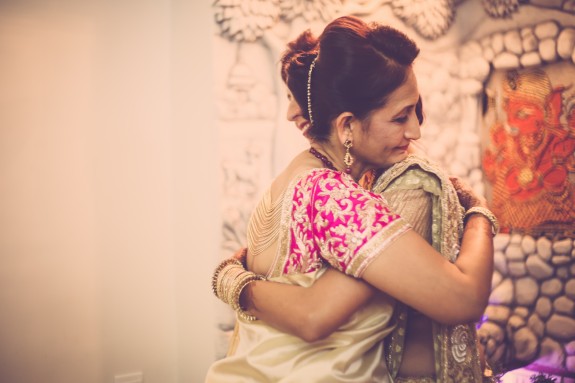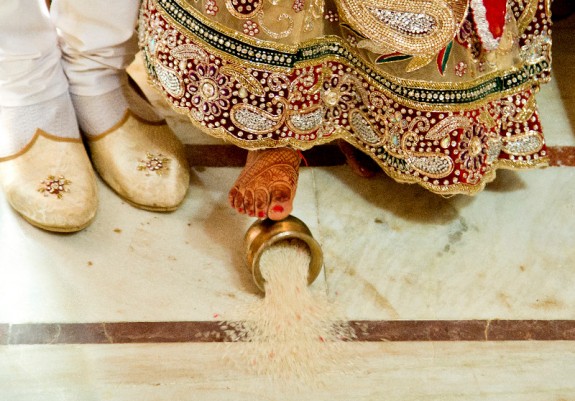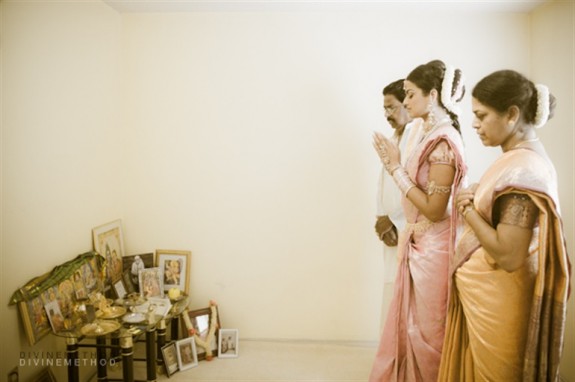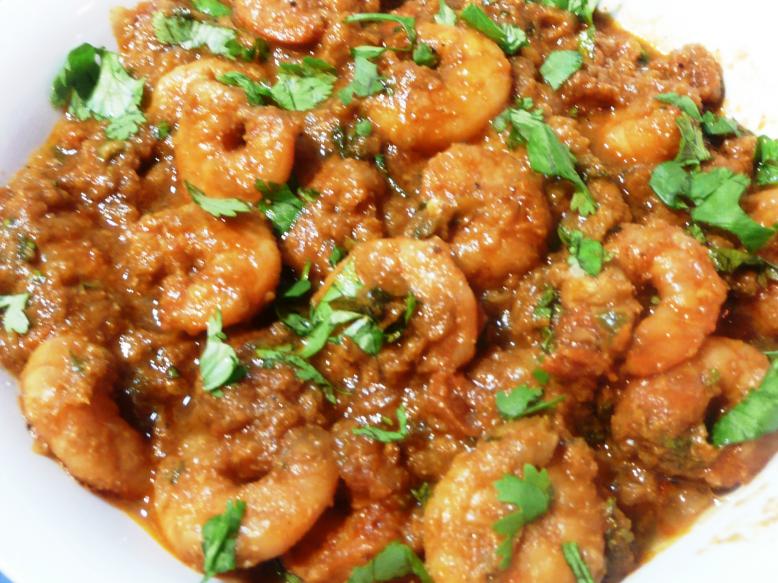After the wedding ceremony and its associated rituals, CKP weddings follow just as many religious, post-wedding traditions. While similar to Maharashtrian post-wedding rituals in many ways, the CKP community observes some traditions uniquely celebrated within the caste, such as the non-vegetarian feast.
View the rest of the CKP Wedding Guide here:
Pre-Wedding/Engagement Rituals
Post Wedding Traditions – You are here!
Varat
The emotional farewell from the bride’s side of the family occurs immediately after the reception, as the newlywed couple leaves to go to the groom’s home to start their lives together. The bride’s family wishes their daughter well and blesses her and her new husband. The groom will sometimes carry the silver Parvati idol (from the Gaurihar puja) with him as he leaves the reception hall – a symbol of his respects for his new wife.
Photo via Nirali & Aman’s Wedding
The farewell procession involves the bride and groom leaving together in a vehicle admist songs and teary goodbyes. While traditionally a sad event where the bride’s family used to send their daughter off to a new village or town to live with her new family, the varat nowadays can be a fun, happy occasion. Music, dancing, and cheer accompany the couple’s car, much like the joy of a baraat ceremony.
Grihapravesh Aarti
This puja is conducted when the bride first enters her new home. The groom’s mother welcomes the newlyweds by washing their feet with milk and water as they cross the threshold, to pay respects to the now “adult” children in their new life.
The bride then kicks a vessel full of rice into the entrance of the home. The rice flowing into the house symbolizes how much prosperity will follow into the home due to the marriage. The groom will then give his bride a new first name, as part of her new role in his family, and write it by parting the grains of the rice.
Photo via Grete Howard
The couple will always enter the house with their right feet first. An aarti will have already begun, with immediate family members in attendance (traditionally, those who also live in the house on the groom’s side of the family).
Soonmukh Baghane
During the aarti that follows the grihapravesh, the groom’s mother will sit between the married couple and look at her new daughter-in-law’s face in a mirror. This is the first vision the groom’s mother has of her new family.
Photo via Tharshini & Dushant’s Wedding
After the aarti verses are recited, the newlywed couple will hand out sugar to the immediate family members who also live in the house with them (or, if they are living alone, the family members who were present at the aarti). The sugar represents the sweetness that married life will bring.
Manpan
This ceremony is a gifting of presents to immediate family as a gesture of familial love and acceptance. The bride’s mother gifts sarees to the groom’s mother and his close female relatives. The bride’s father will gift presents, often clothing, to the men on the groom’s side of the family.
The groom’s family reciprocates the gesture with their own gifts.
This tradition, while technically a post-wedding ritual between a new, larger family, can also be conducted before the official wedding.
Tond Dhune
In addition to the manpan gifts, the bride’s mother will also gift the groom’s mother a piece of jewelry (often made with pearl) and a tea-set.
Vyahi Bhet
In addition to the manpan gifts, the bride’s father will gift the groom’s father a silver ornament or statute (often of a god, to decorate the home). The silver is a symbol of respect and how much this marriage means to the bride’s family.
Halad Utaravarne
When the couple undergoes the halad chadhavane, before the wedding rituals commence, they are not supposed to leave the house or place of marriage. A day after the wedding, once the bride has spent the night in the groom’s home, the groom’s mother will bless the newlywed couple and effectively allow them to go out out of the home. This ritual is the first time the couple will leave their house together as a married couple.
Tikhati Mejwani
This ritual is critical to CKP culture and dietary preferences: as non-vegetarians, CKPs crave meat – especially after a formal wedding in a religious setting where meat is not to be eaten. A day or two after the ceremony, the close family members of the bride and the groom get together to enjoy a non-vegetarian feast.
Photo via www.madhurasrecipe.com
Dishes such as kalvan bhaat (fish and rice) and mutton curry will be heartily eaten, alongside lots of whiskey. This fun lunch is only attended by the immediate family members on both sides of the family.




